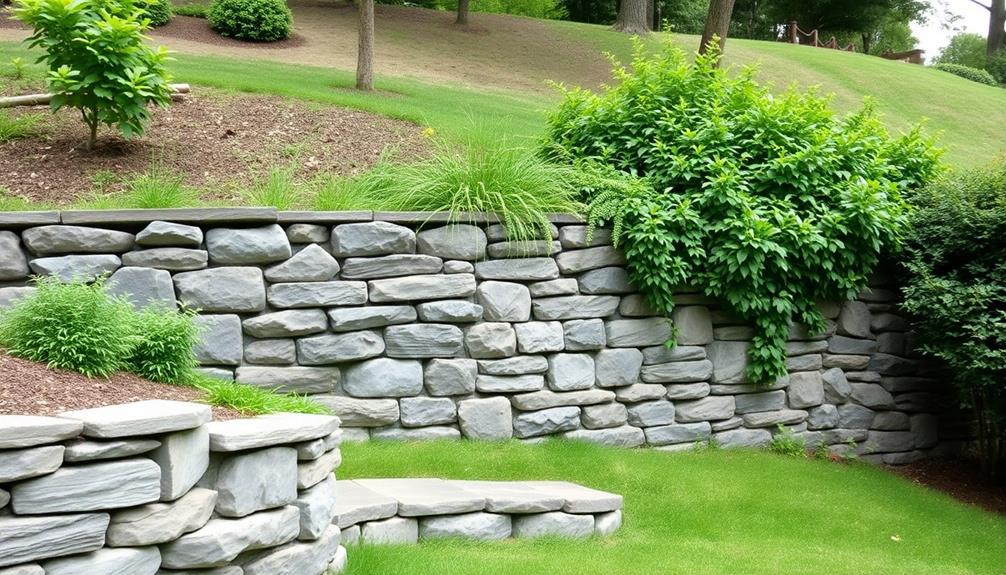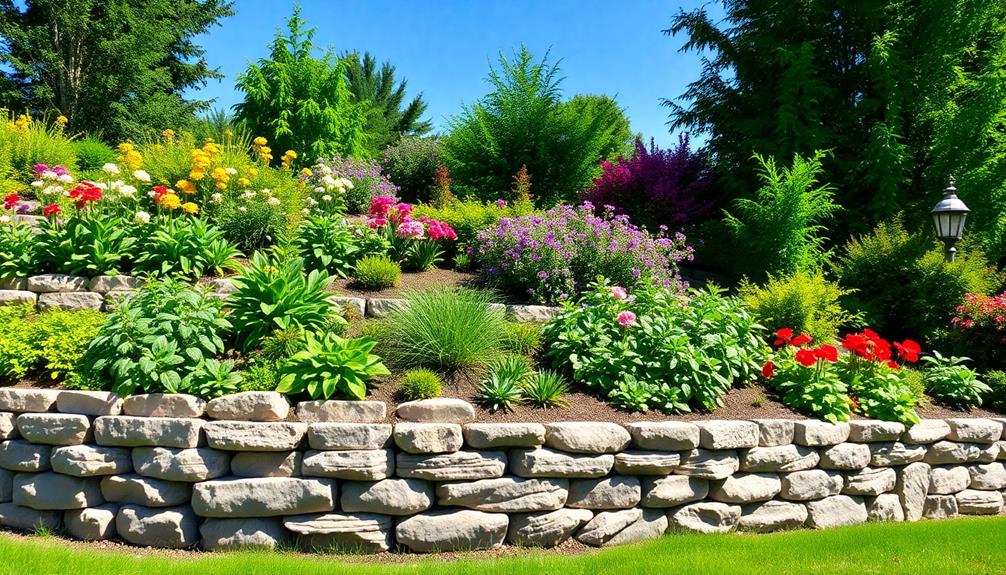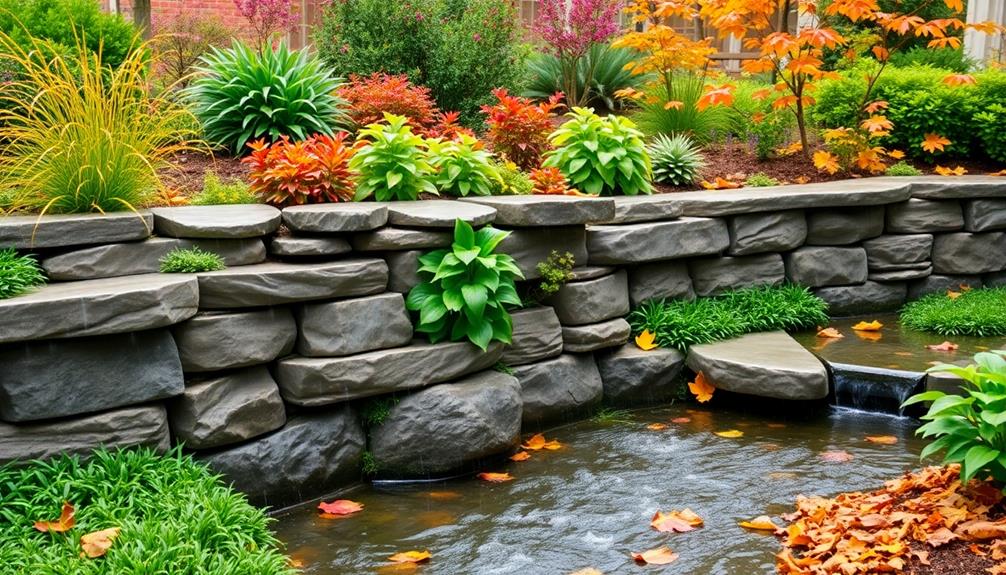Effective maintenance of retaining walls is essential to ascertain their structural soundness, prolong their lifespan, and retain their visual appeal. Regular inspections should be conducted to identify signs of deterioration, such as cracks or water accumulation, and issues should be addressed promptly to prevent costly repairs. Maintaining proper drainage systems and monitoring soil movement are critical to avoid further damage. Cleaning involves removing debris and vegetation encroaching upon the wall, while repair activities may include fixing cracks or replacing materials. Applying protective sealants and strengthening foundations with erosion control enhance durability. Further insights into these preventative measures can substantially aid in maintaining retaining walls.
Table of Contents
ToggleWalls Contractor Highlights
- Conduct regular visual inspections to identify early signs of deterioration.
- Clean and clear debris to maintain drainage system functionality.
- Address minor structural damage promptly to prevent costly repairs.
- Apply protective coatings to extend the wall's lifespan against weathering.
- Monitor and adjust maintenance practices for stability and erosion control.
Definition of Retaining Walls

Retaining walls serve a essential role in providing structural support to terrain slopes and preventing soil erosion, making their purpose and functionality indispensable in both residential and commercial landscapes.
These structures can also create usable areas for gardening, patios, and parking, maximizing the potential of outdoor spaces. They come in various types and materials, including concrete, stone, and timber, each selected for specific project requirements and environmental conditions.
Thoughtful construction and design are paramount, as they influence the wall's durability and effectiveness, ensuring it meets the safety and aesthetic needs of its location.
Purpose and Functionality
A retaining wall is a structural element designed to hold or support soil behind it, effectively altering the natural slope of the land. This modification is essential in terrains where erosion, gravity, and uneven topography challenge stability and usability.
By securing the earth, these walls make certain that our built spaces remain both safe and functional, which is particularly important within communities sharing a common landscape. They provide necessary support by preventing soil movement, protecting structures from damage, and enhancing usable outdoor space.
Retaining walls serve several key purposes:
- Erosion Control: By stabilizing soil, these walls prevent erosion, thereby maintaining landscape integrity and safeguarding property investments.
- Flood Prevention: They help in managing water flow by redirecting runoff, which minimizes the risk of floods and water damage.
- Leveling Terrain: Retaining walls facilitate the creation of level land in hilly areas, allowing for more usable space that fosters community interaction and outdoor activities.
- Property Aesthetic: They enhance the visual landscape, adding structural beauty that increases property value and fosters a sense of pride and belonging within a community.
In essence, the robust functionality of retaining walls is indispensable to integrating natural and developed environments seamlessly, making certain harmony between human habitation and the natural earth.
Types and Materials
Diversity in structural design underpins the effectiveness of retaining walls, where the choice of type and material dictates both function and aesthetic appeal. Retaining walls serve as a critical component in landscape architecture, tasked with holding back earth materials and managing portions of terrain.
Amongst various types, gravity, cantilevered, anchored, and mechanically stabilized earth (MSE) walls cater to disparate landscape challenges. Each employs unique mechanisms to counteract lateral earth pressure, contributing distinct visual and functional qualities desired by property owners.
The selection of materials, ranging from natural stone, poured concrete, timber, to modular blocks, further customizes the wall to specific site conditions and design preferences. Natural stone conveys a classic, enduring quality while also delivering robust structural capability. Concrete, both durable and versatile, can be molded into sleek, modern forms or emulate the texture of stone, seamlessly integrating with diverse architectural styles.
Timber offers a warm, organic appeal, though with a limited lifespan compared to other materials. Modular blocks, often derived from concrete, facilitate a user-friendly construction process and allow for versatile design possibilities.
Through an informed choice of type and materials, retaining walls can harmonize with their surroundings, providing both strength and visual cohesion.
Construction and Design
In the sphere of landscape architecture, the construction and design of retaining walls are pivotal in guaranteeing their functional durability and aesthetic alignment. Retaining walls serve as essential structures crafted to resist lateral pressures exerted by soil, safeguarding the topographical integrity of landscapes. When executed with precision, they not only fulfill critical engineering requirements but also enhance the visual harmony of their surroundings.
Understanding the intricacies of retaining wall construction involves recognizing the balance between structural strength and aesthetic appeal. The process is grounded in meticulous planning and execution attention to detailed design principles and material selection.
To investigate further into the intricacies of constructing and designing these structures, consider the following key elements:
- Foundation Stability: Establish a robust base to support the wall's weight and withstand external forces.
- Drainage Solutions: Implement proper drainage systems to prevent hydrostatic pressure buildup behind the wall.
- Material Selection: Choose materials that complement the environment and meet the functional demands of the site.
- Engineering Precision: Apply accurate calculations and measurements to guarantee structural integrity.
Benefits

Regular maintenance of retaining walls substantially enhances their structural integrity, ensuring longevity and durability while simultaneously heightening their aesthetic appeal. By investing in consistent upkeep, property owners not only preserve the visual harmony of their landscapes but also mitigate the risk of costly repairs over time.
This approach proves to be a cost-effective strategy, as it extends the life of the wall and maintains its functional and visual benefits. Additionally, incorporating routine inspections and addressing minor issues early can prevent considerable damage and preserve the elegance of structures like limestone walls.
Enhanced Structural Integrity
Achieving enhanced structural integrity in retaining walls offers significant benefits, primarily with respect to safety and longevity. This guarantees structures that are not only resilient but also protective, providing an essential service to communities and their members who rely on these robust barriers. Enhanced structural integrity helps mitigate risks associated with soil erosion, water damage, and structural failure, thereby fostering a sense of security and trust among individuals.
Benefits of Enhanced Structural Integrity:
- Safety Assurance: Reliable retaining walls reduce the likelihood of landslides and soil displacement, ensuring safety for individuals living near these constructions.
- Cost-Efficiency: Initial investments in enhancing structural integrity can lead to substantial savings over time by reducing maintenance costs and preventing costly repairs due to potential failures.
- Environmental Preservation: Strong retaining walls assist in maintaining natural landscapes, minimizing ecological disturbances which further align with sustainable development goals.
- Structural Resilience: Enhanced walls withstand unpredictable weather patterns, such as heavy rainfall or earthquakes, offering peace of mind to communities that depend on unwavering infrastructure for their well-being.
Fostering a sense of solidarity, communities benefit from these structures, which serve as enduring guardians against nature's unpredictability, reinforcing bonds through shared peace of mind and stability.
Longevity and Durability
The longevity and durability of retaining walls are paramount for sustaining their functional and aesthetic values over extended periods. Guaranteeing the endurance of these structures requires a dedicated approach to maintenance, which allows them to fulfill their purpose of soil retention while enhancing landscape design.
Prolonged durability stems from using high-quality materials like concrete, stone, or treated wood, each selected for its resistance to environmental wear and tear. By effectively combating erosion and soil displacement, retaining walls foster a stable foundation that benefits homeowners and communities alike.
Regular inspections and prompt repairs contribute markedly to the lifespan of retaining walls. Identifying early signs of wear, such as cracks or bulges, enables timely interventions that prevent further structural degradation. Drainage solutions, such as installing weep holes or using crushed stone backfill, mitigate water-related damage, further bolstering the structure against climatic fluctuations.
In addition, implementing vegetation management helps maintain the structural integrity by preventing root intrusion, which can compromise the wall's stability. Collectively, these practices not only enhance the walls' durability but also guarantee that they remain a source of pride and satisfaction for those residing within the community, creating a sense of shared ownership and care.
Aesthetic Appeal Improvement
While ensuring longevity and durability is central to retaining wall maintenance, enhancing the aesthetic appeal of these structures provides additional benefits that stretch beyond mere functionality. For communities and homeowners alike, an inviting and visually pleasing retaining wall can transform landscapes, fostering a sense of pride and connection to one's surroundings. Improved aesthetics can notably elevate property value while concurrently meeting practical needs. It invites a welcoming atmosphere that goes far beyond the utilitarian.
Enhancing a retaining wall's aesthetic appeal involves several considerations which collectively create a design that is both eye-catching and complementary to its environment, including:
- Material Selection: Choosing materials that harmonize with existing structures and natural surroundings can create a seamless visual shift, making the wall an integral part of the landscape.
- Color Coordination: Incorporating hues that reflect or complement the natural environment or architectural style enhances cohesion between the wall and its context, drawing the overall landscape into harmony.
- Textural Variation: Layering different textures within the wall's design adds depth and intrigue, creating a more dynamic interaction under various lighting conditions.
- Integration of Flora: Incorporating plant life through inclusion in design or by supporting growth around the wall softens hardscape edges and introduces energy to the constructed element.
Cost-Effective Upkeep
Retaining walls, when maintained cost-effectively, guarantee both functionality and fiscal prudence for property owners. The interplay between regular maintenance and strategic investment safeguards longevity, ultimately protecting the structural integrity of retaining walls without overwhelming budgets. This cost-effective approach to maintenance not only eliminates unnecessary expenditures but also fosters a sense of responsibility and inclusion within the community of property stewards who value wise investment and protection of their assets.
Undertaking routine inspections form the bedrock of economically viable maintenance strategies. By identifying early signs of distress such as minor cracks, water seepage, or soil erosion, proactive interventions can be employed, thereby precluding severe damage and costly repairs in the future. Additionally, adopting materials and techniques that align with the specific environmental conditions of a property can prolong the lifespan of retaining walls.
Moreover, employing landscaping that reduces direct water runoff and planting vegetation with deep root systems can mitigate erosion, acting as a natural defense mechanism while preserving the aesthetic appeal. This extensive, cost-conscious maintenance plan not only stabilizes the retaining wall but also preserves the financial well-being of the community it supports, creating a shared sense of security and pride among property owners.
Weather-Related Maintenance Tips

Proper maintenance of retaining walls requires a focus on mitigating weather-related impacts, starting with a thorough inspection for drainage issues to prevent water accumulation that could compromise structural stability. It is also indispensable to regularly check for signs of erosion, which can be exacerbated by seasonal rainfall or snowmelt, potentially leading to undermined support or collapsed sections. Furthermore, monitoring for frost heaving is essential as temperatures fluctuate, which can cause the soil to expand and contract, leading to damaging shifts or displacements in the wall's alignment.
| Maintenance Aspect | Potential Issues | Recommended Action |
|---|---|---|
| Drainage Inspection | Water Accumulation | Clear Blockages, Install Drains |
| Erosion Check | Soil Displacement | Reinforce with Geotextiles |
| Frost Heaving Monitoring | Structural Shifts | Adjust Wall Footings |
| Seasonal Changes | Temperature Variations | Install Weather Barriers |
| Regular Assessments | General Wear and Tear | Schedule Bi-Annual Reviews |
Inspect for Drainage Issues
A critical aspect of weather-related maintenance for retaining walls is the inspection for drainage issues. Ensuring adequate drainage is indispensable to the integrity of retaining walls, as it prevents water buildup which can destabilize the structure. Proper maintenance requires regular inspections, especially following heavy rainfall or snowfall. This proactive approach serves to fortify the collective efforts of property owners who seek to maintain a safe and resilient environment.
To effectively inspect for drainage issues, consider these four key steps:
- Visual Inspection: Examine the wall for signs of water pooling or dampness. Stains or mineral deposits on the wall's surface may indicate persistent moisture problems.
- Evaluate Drainage Systems: Confirm that drains, weep holes, or swales are unobstructed, allowing water to flow freely away from the wall. Blockages here can lead to pressure buildup and potential structural damage.
- Check Grading: Ensure that the surrounding terrain slopes away from the wall. Proper grading is essential to direct surface runoff far from the structure.
- Monitor After Storms: After heavy rains, walk along the wall to verify that water does not settle around its base. Implement corrective measures if necessary, reinforcing the unity and strength within the community of conscientious property caretakers.
Check for Erosion Signs
Erosion presents one of the most significant threats to the longevity and stability of retaining walls. It is imperative for property owners and maintenance professionals to diligently monitor for signs of erosion, as early detection and intervention can prevent more severe structural issues. The indications of erosion can be subtle, yet understanding how to recognize these signs is indispensable in safeguarding the integrity of any retaining wall.
Begin by examining the area immediately surrounding the wall. Look for signs of soil displacement, such as gullying or fissures, which indicate that water flow is washing away supportive ground material. Pay attention to the wall's base and any exposed areas where soil seems depleted. Changes in vegetation, such as wilting or dying plants, might also suggest excessive water drainage or soil loss, both of which contribute to erosion.
Furthermore, inspect the wall itself for any new or expanding cracks, a common consequence of compromised foundation support. Deformed or leaning sections of a wall can further imply underlying erosion issues. Regular assessments guarantee early detection, enabling timely mitigation strategies that reinforce the wall and restore peace of mind among those who depend on its stability and safety.
Monitor Frost Heaving
How does frost heaving impact the structural integrity of retaining walls? Frost heaving occurs when water trapped within the soil freezes and expands, exerting upward pressure on the retaining wall. This pressure can lead to cracks, misalignment, or bulging, thereby compromising the wall's structural integrity over time. To guarantee the longevity and reliability of retaining walls, monitoring frost heaving becomes essential, especially in regions with harsh winter conditions.
A systematic approach can effectively mitigate the impacts of frost heaving. Consider the following practices:
- Material Selection: Utilize frost-resistant materials, ensuring that foundational components are less prone to heaving stress.
- Drainage Assessment: Implement efficient drainage systems that allow water to move away from the wall, reducing the likelihood of water retention and subsequent freezing.
- Thermal Insulation: Apply insulation barriers to stabilize soil temperatures, which can minimize significant fluctuations and prevent frost heaving.
- Regular Inspections: Conduct thorough inspections before, during, and after winter months to identify early warning signs of structural distress, enabling timely intervention.
Adopting these practices not only enhances the durability of retaining walls but also fosters a sense of security and belonging within the community. Embracing preventative measures can transform perceptions, merging individual contributions into a collective guardianship of shared spaces.
Walls Contractor FAQ
How Often Should I Inspect My Retaining Wall for Damage?
Regular inspections of your retaining wall are essential for community safety and cohesion, ideally conducted bi-annually. This guarantees early detection of potential issues, promoting collective well-being through proactive maintenance and fostering a secure and integrated environment.
What Tools Are Recommended for Cleaning a Retaining Wall?
For cleaning a retaining wall, a pressure washer, stiff-bristle brush, and mild detergent are recommended. Regular cleaning guarantees structural integrity, reflecting a shared commitment to preserving the community's aesthetic and functional well-being.
Are There Signs That Indicate My Retaining Wall Needs Professional Attention?
Key indicators that your retaining wall requires professional intervention include visible cracks, tilting, water pooling, or soil erosion. Addressing these signs promptly guarantees structural integrity and fosters a supportive environment within your community, prioritizing both safety and aesthetics.
Can Landscaping Around a Retaining Wall Affect Its Stability?
Landscaping around a retaining wall markedly impacts its stability. Overwatering, improper plant selection, and root expansion can compromise structural integrity. Utilizing compatible vegetation and ensuring proper drainage maintains both aesthetic appeal and mutual trust in the community's shared spaces.
How Do I Prevent Pest Infestations in My Retaining Wall?
To prevent pest infestations in retaining walls, guarantee proper drainage and eliminate excessive moisture, which attracts pests. Regularly inspect for cracks or crevices, sealing them promptly. Maintain cleanliness around the wall to discourage nesting and breeding grounds for pests.







